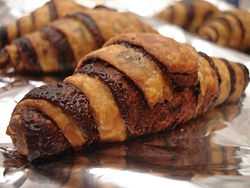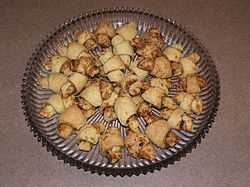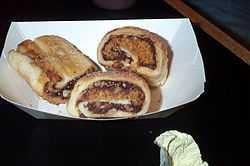Rugelach
| Rugelach | |
|---|---|
| Pastry | |
 Chocolate rugelach | |
| Main ingredient(s): | |
|
Dough: sour cream or cream cheese Filling: any of raisins, walnuts, cinnamon, chocolate, marzipan, poppy seed, or fruit preserves | |
| Recipes at Wikibooks: | |
|
| |
| Media at Wikimedia Commons: | |
|
|


Rugelach (/ˈruːɡələx/; Yiddish: רוגעלך), other spellings: rugelakh, rugulach, rugalach, ruggalach, rogelach (all plural), rugalah, rugulah, rugala (singular), is a Jewish pastry of Ashkenazic origin.
Traditional rugelach are made in the form of a crescent by rolling a triangle of dough around a filling.[1][2] Some sources state that the rugelach and the French croissant share a common Viennese ancestor, crescent-shaped pastries commemorating the lifting of the Turkish siege,[3] possibly a reference to the Battle of Vienna in 1683. This appears to be an urban legend however, as both the rugelach and its supposed ancestor, the Kipferl, pre-date the Early Modern era, while the croissant in its modern form did not originate earlier than the 19th century (see viennoiserie).
An alternative form is constructed much like a strudel or nut roll, but unlike those, the rolled dough and filling is cut into slices before baking.[4]
Etymology
The name is Yiddish, the Jewish language of eastern Europe. The ach ending (ך) indicates plural, while the el (ל) can be a diminutive, as, for example, shtetlekh (שטעטלעך, villages) is the plural of shtetl (שטעטל, village), the diminutive of shtot (שטאָט, town). In this case, the root means something like "twist" so the translation would be "little twists," a reference to the shape of this cookie.[3] In this context, note that rog (ראָג) means "corner" in Yiddish,.[5] In Polish, which influenced (and was in turn influenced by) Yiddish, "róg" can mean "corner", but can also means "horn"—both the kind on an animal and the musical kind. Croissant-shaped pastries, which look like horns, are called in Polish "rogale" pl:Rogal świętomarciński. That word is almost identical in pronunciation and meaning to the Yiddish "rugelach".
Alternatively, some assert that the root is rugel, meaning royal, possibly a reference to the taste.[6] This explanation is in conflict with Yiddish usage, where the word keniglich (קעניגליךּ) is the dominant word meaning royal.[7]
Finally, in modern Hebrew, they are known as roglìt (רוֹגְלִית), a postbiblical Hebrew word meaning "trailing vines".[8] The Yiddish word ruglach probably came first. The modern Hebrew is probably a neologism, chosen for its similarity to the Yiddish and its descriptive meaning.
Ingredients
Rugelach can be made with sour cream or cream cheese[1][2][3] doughs, but there are also pareve variants with no dairy ingredients,[9] so that it can be eaten with or after a meat meal and still be kosher. Cream cheese doughs are the most recent, probably American innovations, while yeast leavened[9][10] and sour cream doughs[11][12] are much older.
The different fillings can include raisins, walnuts, cinnamon, chocolate, marzipan, poppy seed, or fruit preserves which are rolled up inside.
Cultural
Rugelach is a traditional Jewish food that is eaten any time of year, including, but not limited to Shabbat. Despite the fact that it is not fried in oil, they are traditional on Hanukkah.[1][2]
See also
References
- ↑ 1.0 1.1 1.2 Joan Nathan, Joan Nathan's Jewish Holiday Cookbook, Schocken, 2004; page 284.
- ↑ 2.0 2.1 2.2 Judith M. Fertig, All American Desserts, Harvard Common Press, 2003; page 135.
- ↑ 3.0 3.1 3.2 Gil Marks, The World of Jewish Cooking, Simon and Schuster, 1996; page 326.
- ↑ Joseph Amendola and Nicole Rees, The Baker's Manual, Wiley, 2003; page 223.
- ↑ Alexander Harkavy, A Dictionary of the Yiddish Language, 1898; page 312.
- ↑ Lois Young-Tulin, Chapter 5: Mandelbrot, Rugelach and a Family Quilt, in Jewish Mothers Tell their Stories, Hayworth Press, 2000; page 45
- ↑ Alexander Harkavy, A Dictionary of the Yiddish Language, 1898; page 308.
- ↑ Ernest Klein, A Comprehensive Etymological Dictionary of the Hebrew Language, McMillan, 1987; page 609.
- ↑ 9.0 9.1 The Taste of Shabbos, Aish HaTorah, 1987; page 118.
- ↑ Judy Bart Kancigor, Cooking Jewish, Workman, 2007; page 474.
- ↑ Barbara Grunes, Best-Ever Rugelach, The Best Bake Sale Ever Cookbook, Raincoast Books, Vancouver, 2006; page 68.
- ↑ Helene Siegel and Karen Gillingham, Ida's Rugelach, Totally Cookies Cookbook, Celestial Arts Publishing, Berkeley, 1995; page 74.
External links
- Rugalach Recipes
- "Rugelach--Elsie Waldman's Recipe" from The Jewish Cookbook by Mildred Grosberg Bellin